Numerical Simulation Study on Combustion Characteristics of a Low-Speed Marine Engine Using Biodiesel
Abstract
1. Introduction
2. Materials and Methods
2.1. Testing Equipment
2.2. Geometric Model Establishment and Mesh Generation
2.3. Initial and Boundary Conditions
2.4. Verification of Simulation Model
3. Results and Discussion
3.1. Impact of Different EGR Rates on Combustion in Low-Speed Engines
3.2. Effects of Different EGR Rates on Emission Characteristics
3.3. Effects of Different Injection Timings on Combustion Characteristics
3.4. Effects of Different Injection Timings on Emission Characteristics
4. Conclusions
- (1)
- As the EGR rate climbs, the oxygen level in the intake air drops, slowing the combustion rate. The exhaust components also lower the in-cylinder combustion temperature. Specifically, at EGR rates of 5%, 10%, and 15%, the cylinder pressure decreases by 2.17%, 4.61%, and 9.03%, respectively; the peak average in-cylinder temperature reduces by 3.27%, 6.15%, and 10.9%, respectively; NOx emissions drop by 35.13%, 59.95%, and 85.21%, respectively; while soot emissions increase by 12.25%, 26.75%, and 58.18%, respectively.
- (2)
- Delaying the injection timing shortens the ignition delay period, increases the proportion of diffusion combustion, and causes uneven fuel–air distribution. When the injection timing is advanced to 0 °CA, the peak cylinder pressure rises by 10.27%, the peak average temperature increases by 3.23%, NOx emissions go up by 23.04%, and soot emissions drop by 7.42%. When it is delayed to 4 °CA and 6 °CA, the peak cylinder pressure falls by 12.17% and 20.90%, respectively; the peak average temperature decreases by 3.77% and 6.93%, respectively; NOx emissions are cut by 16.01% and 25.44%, respectively; and soot emissions rise by 4.98% and 11.64%, respectively.
Author Contributions
Funding
Data Availability Statement
Conflicts of Interest
References
- Qian, Y.; Liu, B.; Wu, Z. Review of the development of marine low-speed engine technology. J. Propuls. Technol. 2020, 41, 2418–2426. [Google Scholar]
- Deng, J.; Wang, X.; Wei, Z.; Wang, L.; Wang, C.; Chen, Z. A review of NOx and SOx emission reduction technologies for marine diesel engines and the potential evaluation of liquefied natural gas fuelled vessels. Sci. Total Environ. 2021, 766, 144319. [Google Scholar] [CrossRef] [PubMed]
- Nikolić, D.; Marstijepović, N.; Cvrk, S.; Gagić, R.; Filipović, I. Evaluation of pollutant emissions from two-stroke marine diesel engine fueled with biodiesel produced from various waste oils and diesel blends. Brodogradnja 2017, 67, 81–90. [Google Scholar] [CrossRef]
- Gharehghani, A.; Mirsalim, M.; Hosseini, R. Effects of waste fish oil biodiesel on diesel engine combustion characteristics and emission. Renew. Energy 2017, 101, 930–936. [Google Scholar]
- Nabi, M.N.; Zare, A.; Hossain, F.M.; Ristovski, Z.D.; Brown, R.J. Reductions in diesel emissions including PM and PN emissions with diesel-biodiesel blends. J. Clean. Prod. 2017, 166, 860–868. [Google Scholar] [CrossRef]
- Yusuf, A.A.; Inambao, F.L.; Ampah, J.D. Evaluation of biodiesel on speciated PM2.5, organic compound, ultrafine particle and gaseous emissions from a low-speed EPA Tier II marine diesel engine coupled with DPF, DEP and SCR filter at various loads. Energy 2022, 239 Pt A, 121837. [Google Scholar] [CrossRef]
- Nghia, N.T.; Khoa, N.X.; Cho, W.; Lim, O. A Study the Effect of Biodiesel Blends and the Injection Timing on Performance and Emissions of Common Rail Diesel Engines. Energies 2021, 15, 242. [Google Scholar] [CrossRef]
- Visan, N.A.; Carlanescu, R.; Niculescu, D.C.; Chiriac, R. Study on the Cumulative Effects of Using a High-Efficiency Turbocharger and Biodiesel B20 Fuelling on Performance and Emissions of a Large Marine Diesel Engine. J. Mar. Sci. Eng. 2022, 10, 1403. [Google Scholar] [CrossRef]
- Zhang, D.; Qi, D.H.; Liu, Z.C.; Liu, G.; Shen, Y.J. Experimental study on diesel engine fueled with rapeseed oil-diesel blended fuel. Renew. Energy Resour. 2023, 41, 725–730. [Google Scholar] [CrossRef]
- Zhao, X.; Jiaqiang, E.; Liao, G.; Zhang, F.; Chen, J.; Deng, Y. Numerical simulation study on soot continuous regeneration combustion model of diesel particulate filter under exhaust gas heavy load. Fuel 2021, 290, 119795. [Google Scholar] [CrossRef]
- Jensen, M.V.; Cordtz, R.F.; Schramm, J. Numerical analysis of methane slip source distribution in a four-stroke dual-fuel marine engine. J. Mar. Sci. Technol. 2020, 26, 606–617. [Google Scholar] [CrossRef]
- Namitha, B.; Sathish, A.; Kumar, P.S.; Nithya, K.; Sundar, S. Micro algal biodiesel synthesized from Monoraphidium sp., and Chlorella sorokiniana: Feasibility and emission parameter studies. Fuel 2021, 301, 121063. [Google Scholar] [CrossRef]
- Mourad, M.; Mahmoud, K.R.M.; NourEldeen, E.-S.H. Improving diesel engine performance and emissions characteristics fuelled with biodiesel. Fuel 2021, 302, 121097. [Google Scholar] [CrossRef]
- Alosius, M.A.; Thomai, P.; Thomas, J.J.; Sharma, V. Impact of Combined Effects of Injection Pressure and EGR on Modified Stationary Engine Fuelled with Biodiesel Blend Made of Waste Feedstock Oils. Arab. J. Sci. Eng. 2023, 48, 12389–12405. [Google Scholar] [CrossRef]
- Gu, Y.L.; Zheng, P.; Wu, X.X. Effect of EGR rate on combustion performance and emission characteristics of biodiesel. Small Int. Combust. Engine Motorcycle 2019, 6, 59–64. [Google Scholar] [CrossRef]
- Yu, J.S.; Li, W.H.; Yan, F.W. Effect of EGR on combustion and emission performance of n-pentanol-biodiesel blended fuel. Combust. Sci. Technol. 2021, 27, 279–288. [Google Scholar]
- Ji, W.X.; Zhu, L.; Lv, X.C.; Huang, Z. Effect of EGR rate on combustion and emission characteristics of low-speed two-stroke marine diesel engine. Ship Eng. 2019, S1, 4. [Google Scholar]
- Jiang, X.X.; Wei, H.Q.; Zhou, L. Numerical Study on the Effects of Multiple-Injection Coupled with EGR on Combustion and NOx Emissions in a Marine Diesel Engine. Energy Procedia 2019, 158, 4429–4434. [Google Scholar] [CrossRef]
- Sun, X.X.; Liang, X.Y.; Shu, G.Q.; Lin, J.; Wang, Y.; Wang, Y. Numerical investigation of two-stroke marine diesel engine emissions using exhaust gas recirculation at different injection time. Ocean Eng. 2017, 144, 90–97. [Google Scholar] [CrossRef]
- Ji, W.X.; Li, A.; Lu, X.C.; Huang, Z.; Zhu, L. Numerical study on NOx and ISFC co-optimization for a low-speed two-stroke engine via Miller cycle, EGR, intake air humidification, and injection strategy implementation. Appl. Therm. Eng. 2019, 153, 398–408. [Google Scholar] [CrossRef]
- Yang, J.B.; Wang, B.B.; Gao, Z.B.; Mao, J.; Tang, M.Y.; Wo, X.Z. Optimization of the Effect of Blending Biodiesel Coupled with EGR on Diesel Engine Performance. Ship Eng. 2022, 44, 9. [Google Scholar]
- Sun, Y.; Lv, L.; Wen, M. Experimental study on reducing BC emissions from a low-speed marine engine by using blended biodiesel and a nitro additive. Process Saf. Environ. Prot. 2024, 185, 1232–1249. [Google Scholar] [CrossRef]
- Chang, Y.C.; Jia, M.; Li, Y.P.; Zhang, Y.; Xie, M.; Wang, H.; Reitz, R.D. Development of a skeletal oxidation mechanism for biodiesel surrogate. Proc. Combust. Inst. 2015, 35, 3037–3044. [Google Scholar] [CrossRef]
- Lu, Z.; Liu, M.Y.; Shi, L.; Wang, T.; Lu, T.; Wang, H. Numerical research of the injected exhaust gas recirculation strategy on a two-stroke low-speed marine diesel engine. Energy 2022, 244, 122731. [Google Scholar] [CrossRef]
- Yang, K. Numerical Study on Combustion Process of Large Bore Low Speed Two Stroke Marine Diesel Engine. Master’s Thesis, Tianjin University, Tianjin, China, 2019. [Google Scholar] [CrossRef]
- Jin, W. Numerical Simulation of Knocking in Two-Stroke Marine Dual-Fuel Engine. Master’s Thesis, Dalian Maritime University, Dalian, China, 2023. [Google Scholar] [CrossRef]


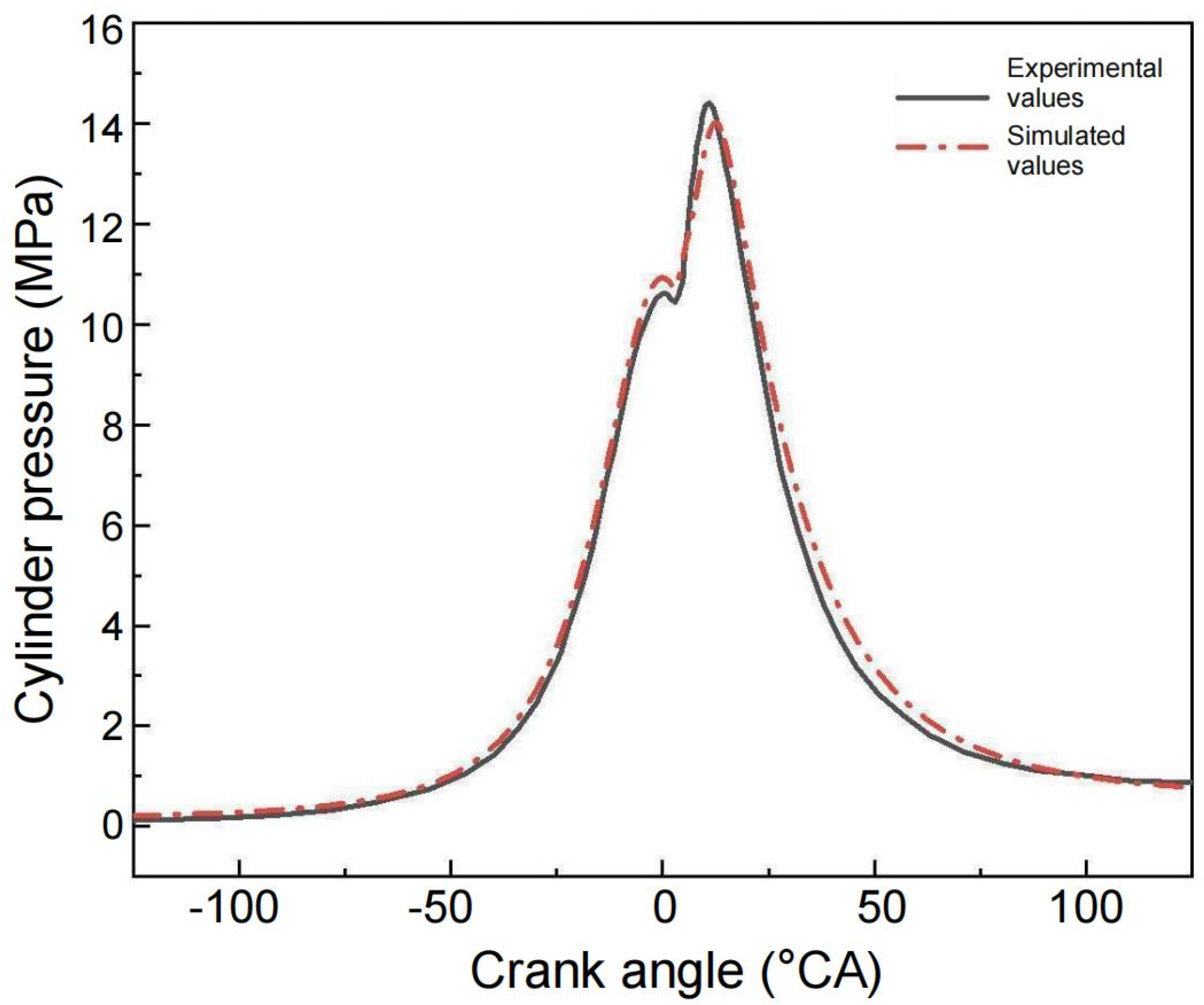

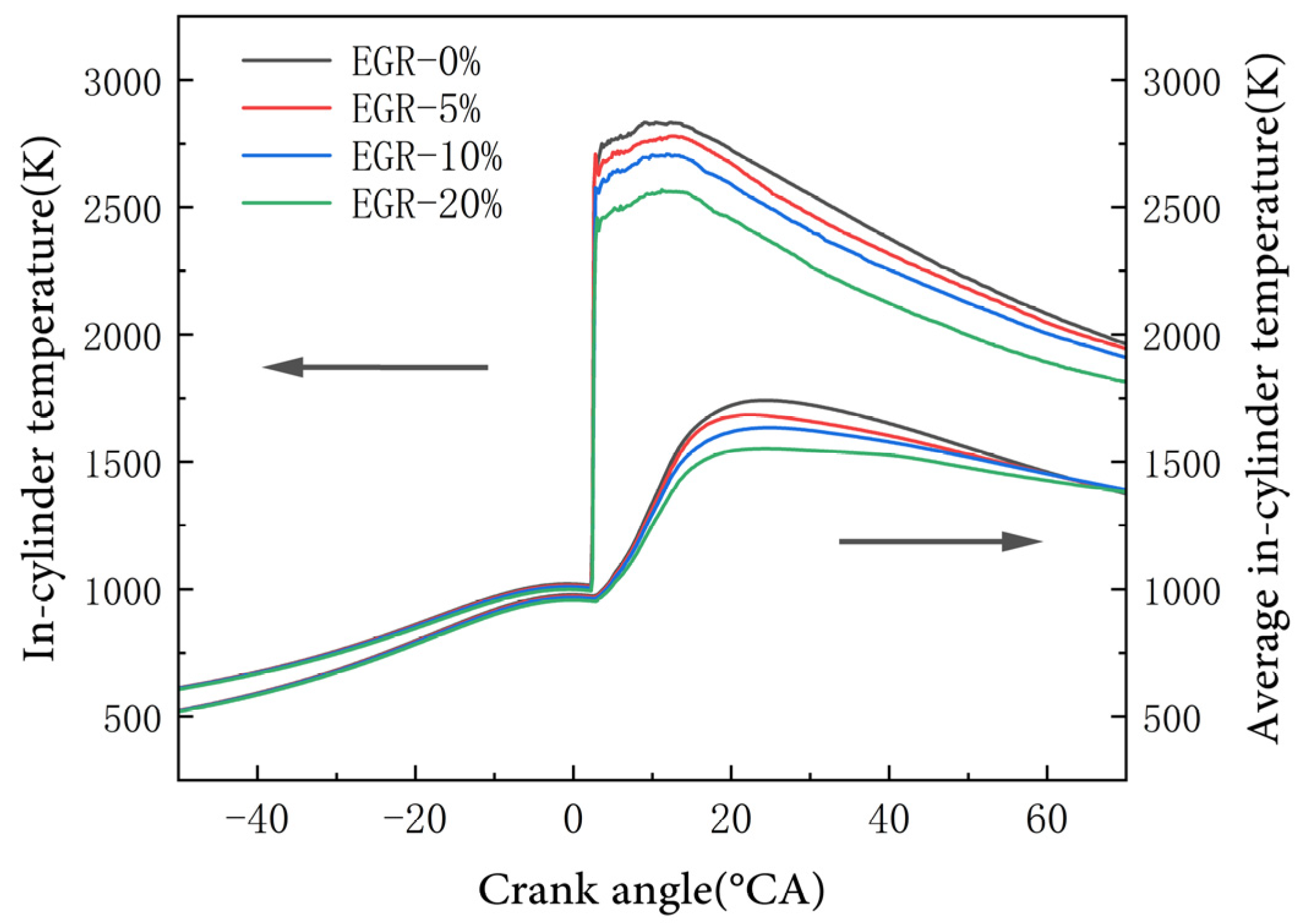
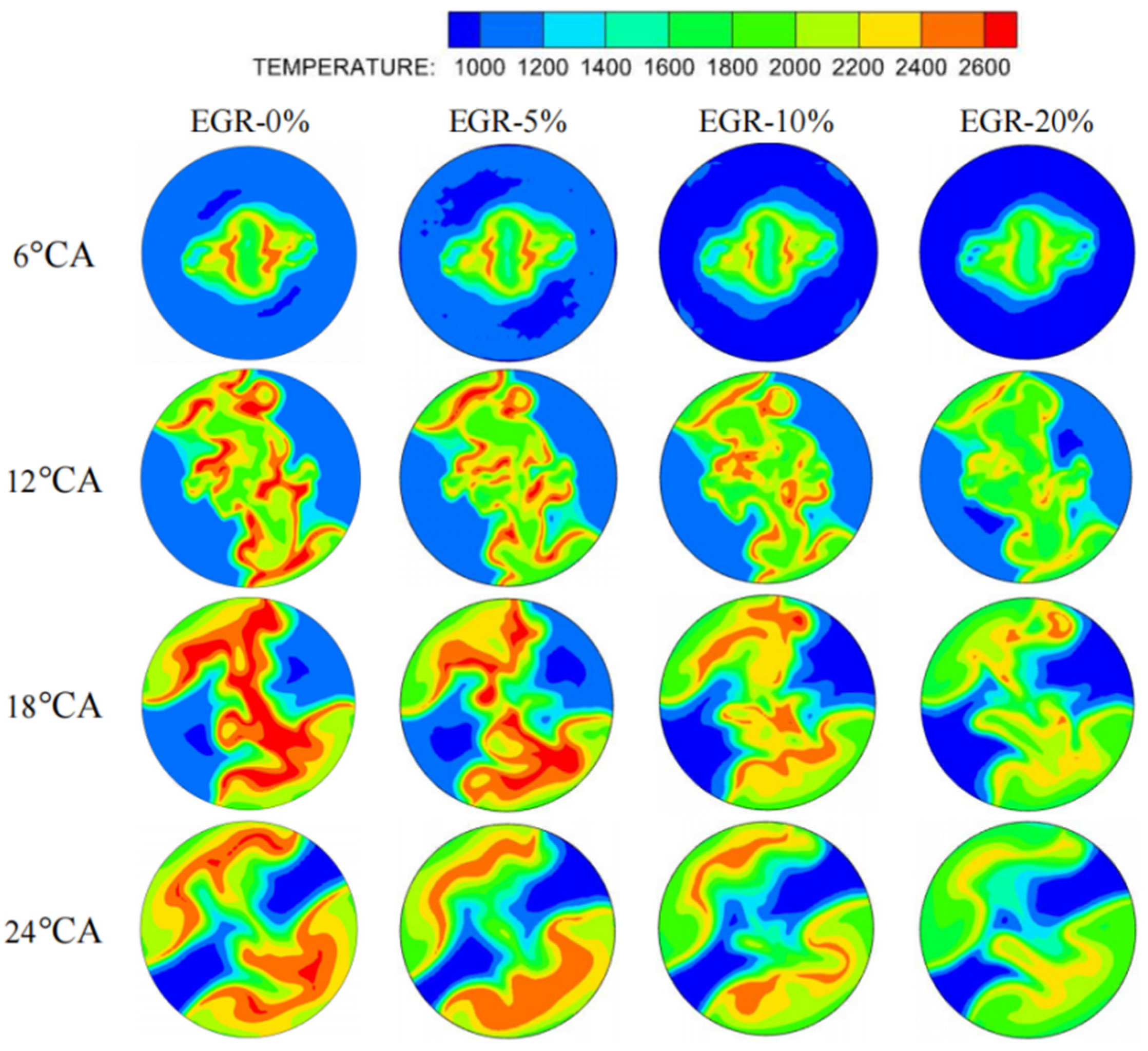
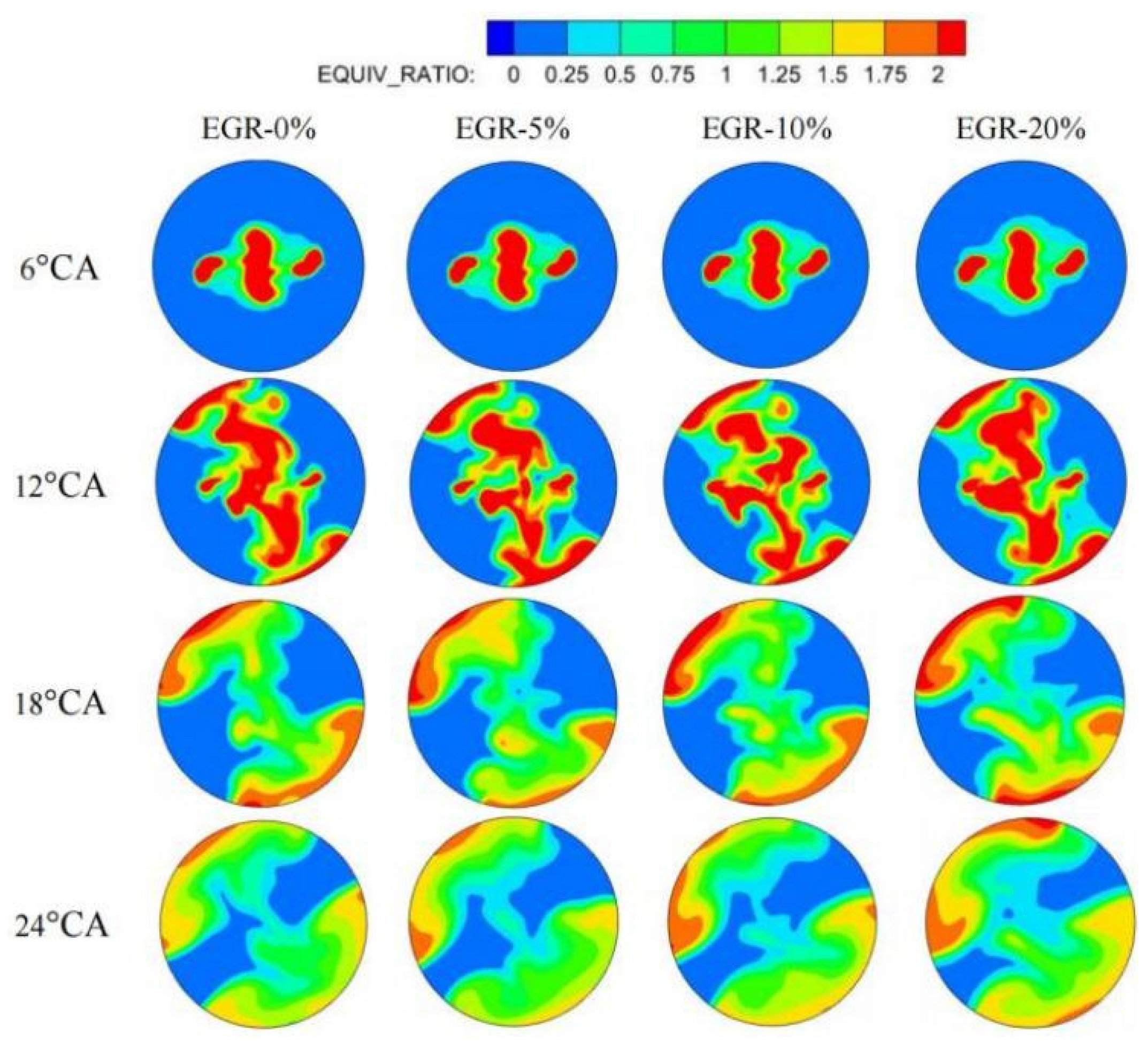

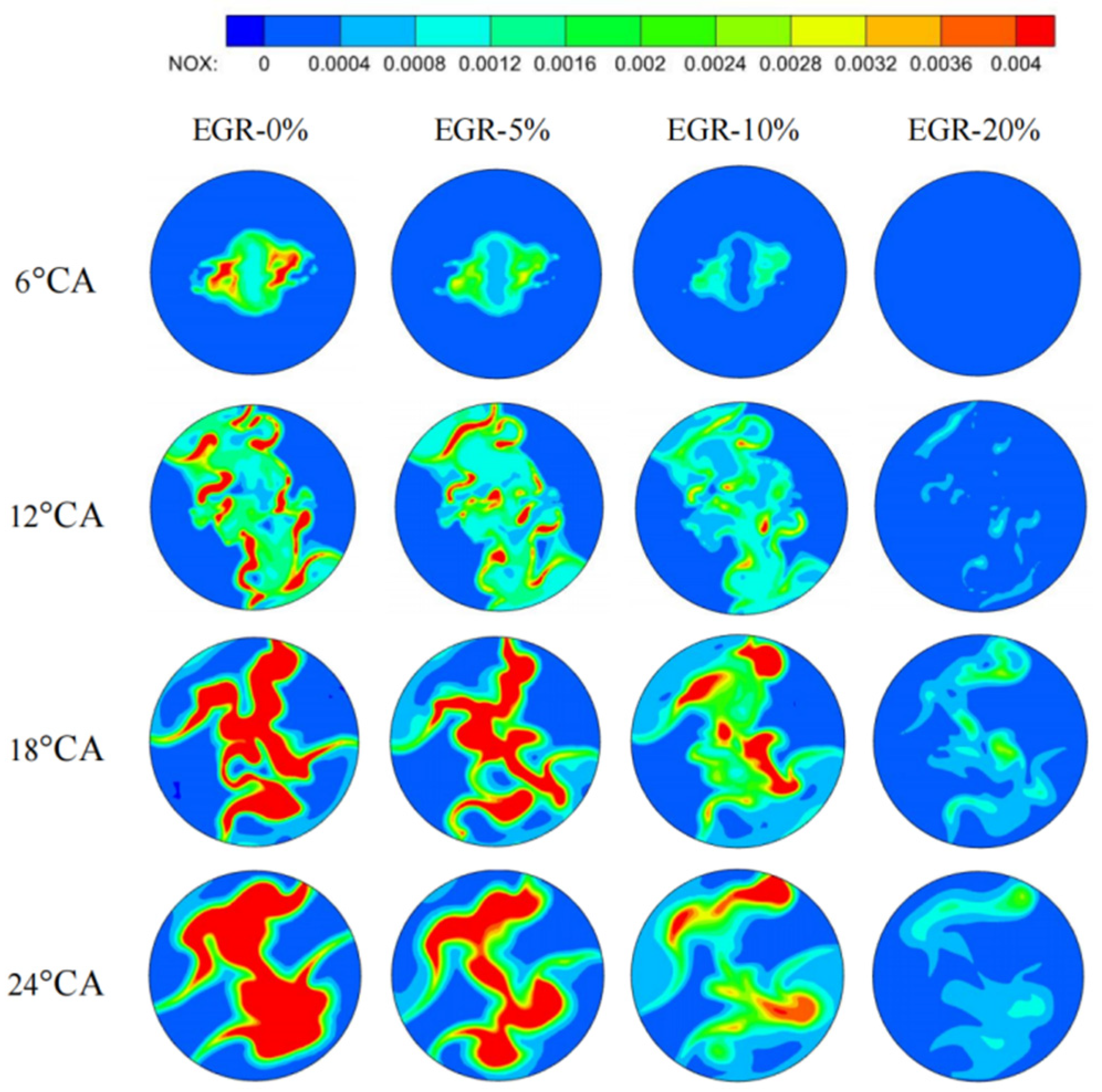
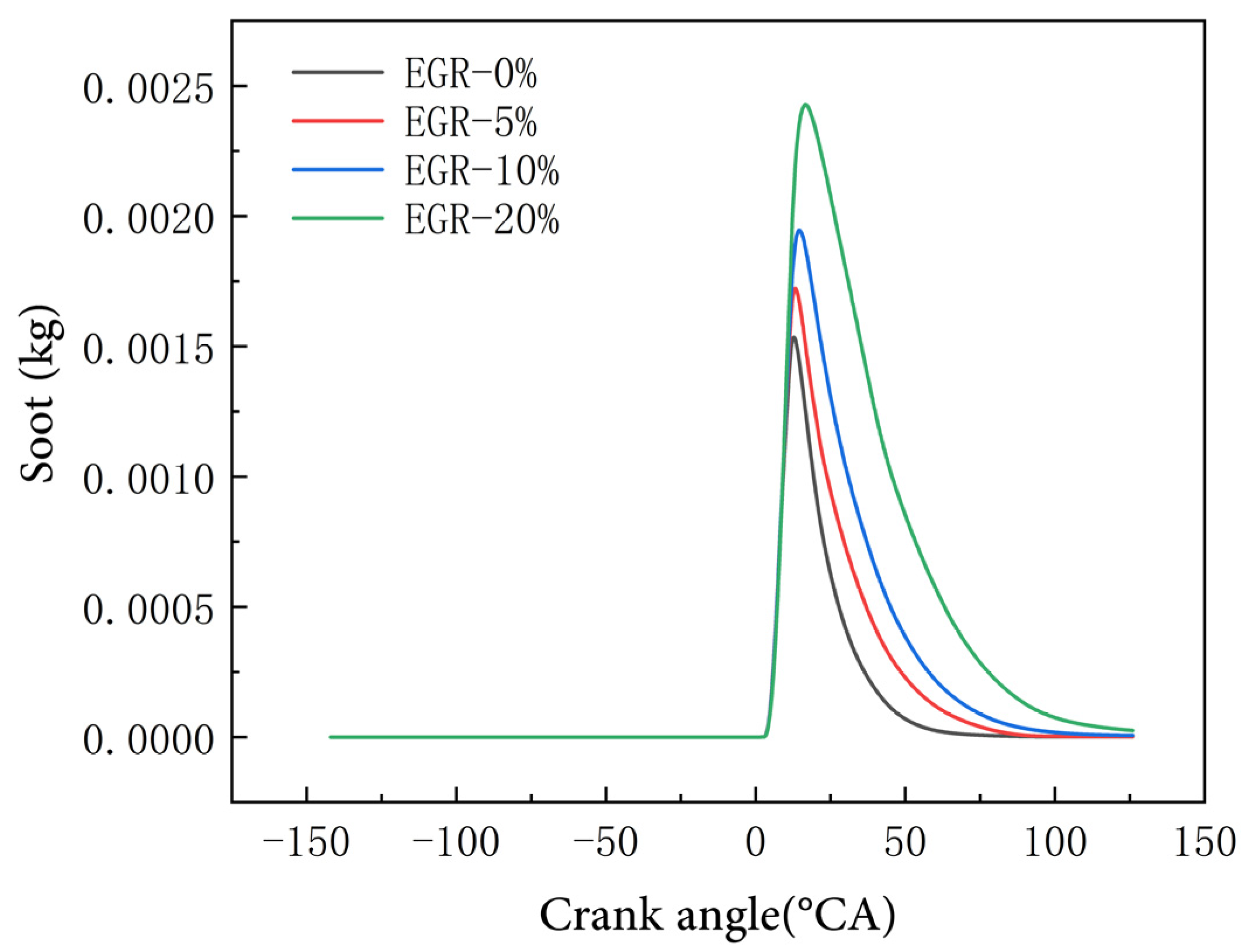
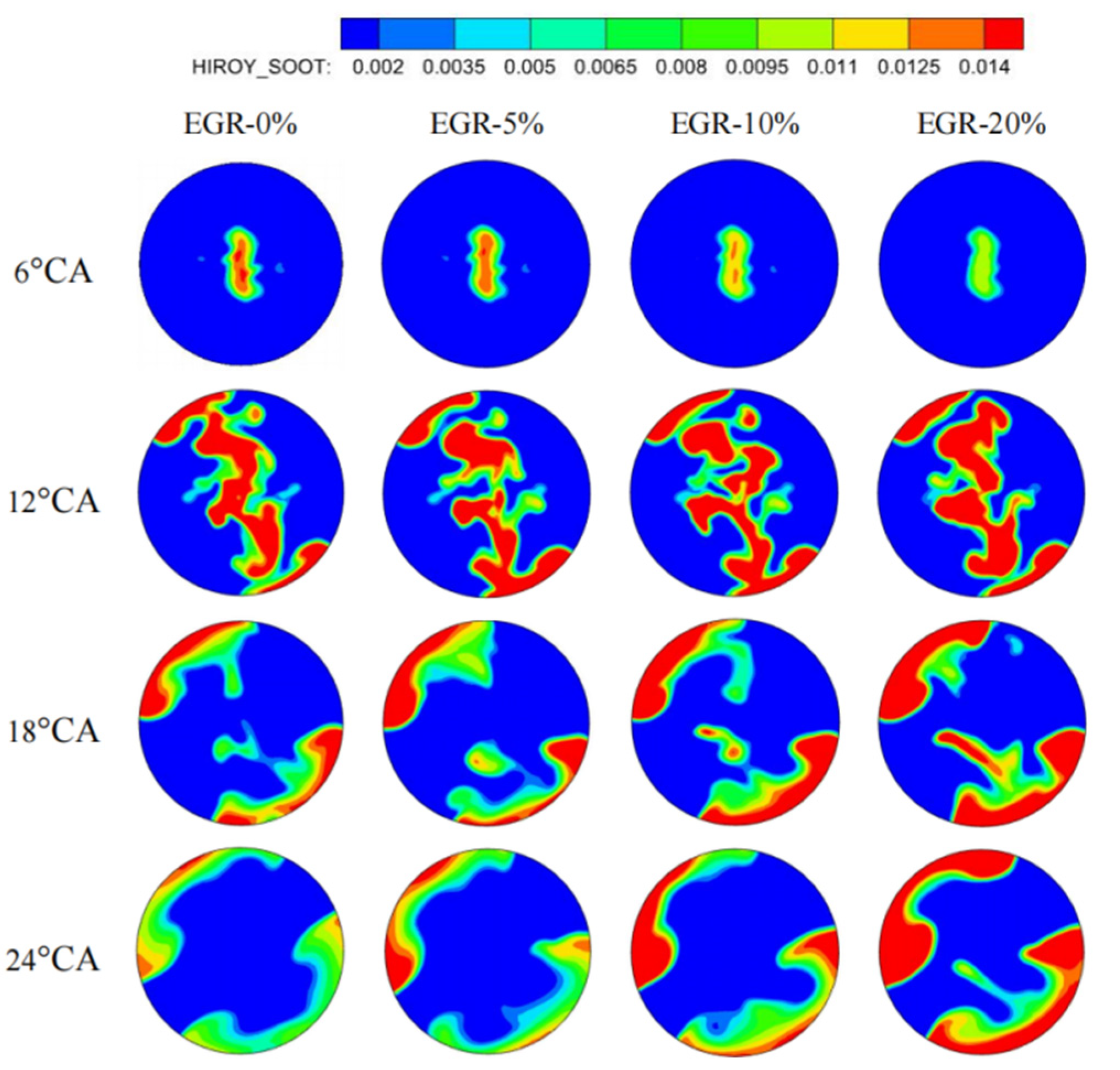

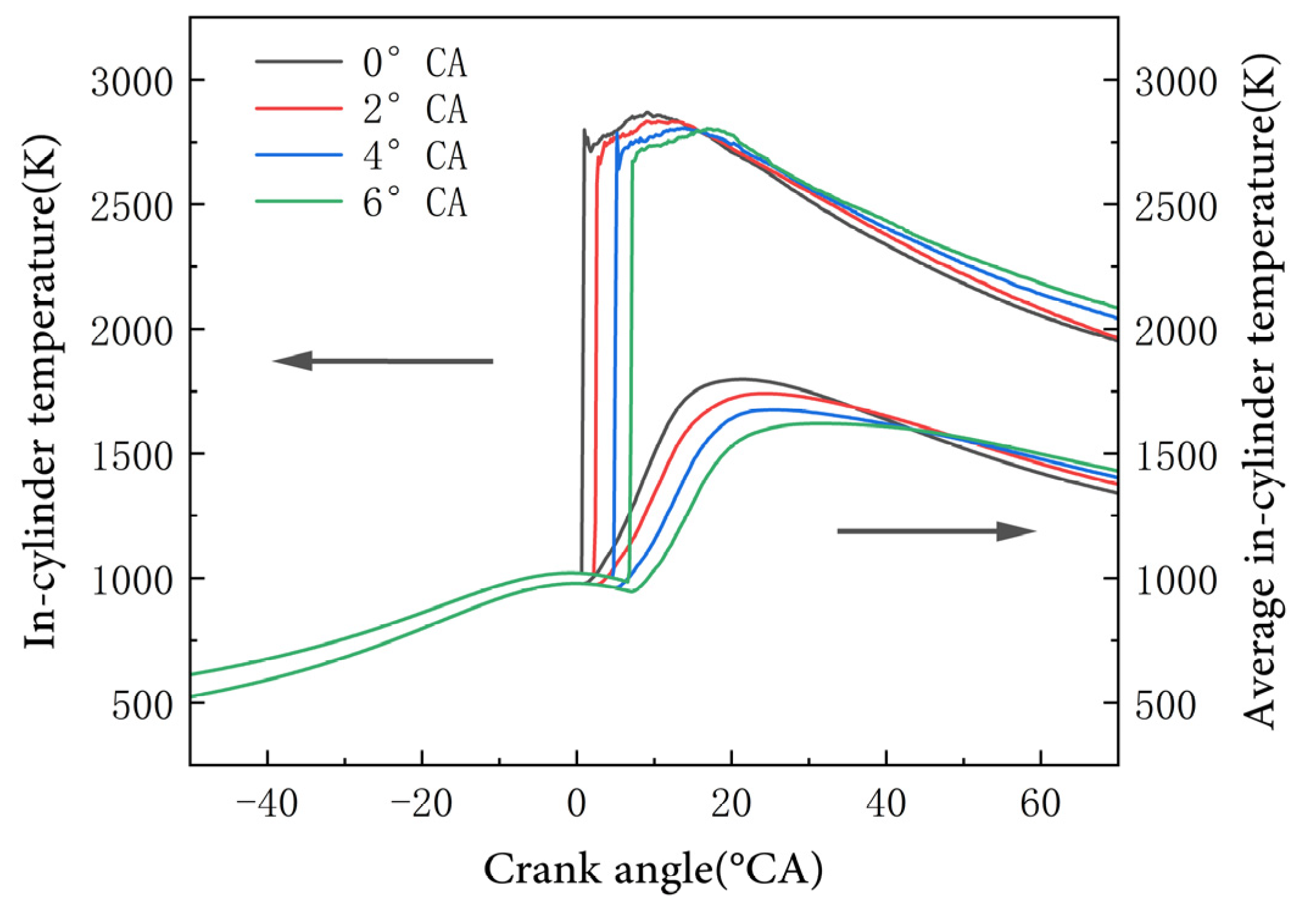



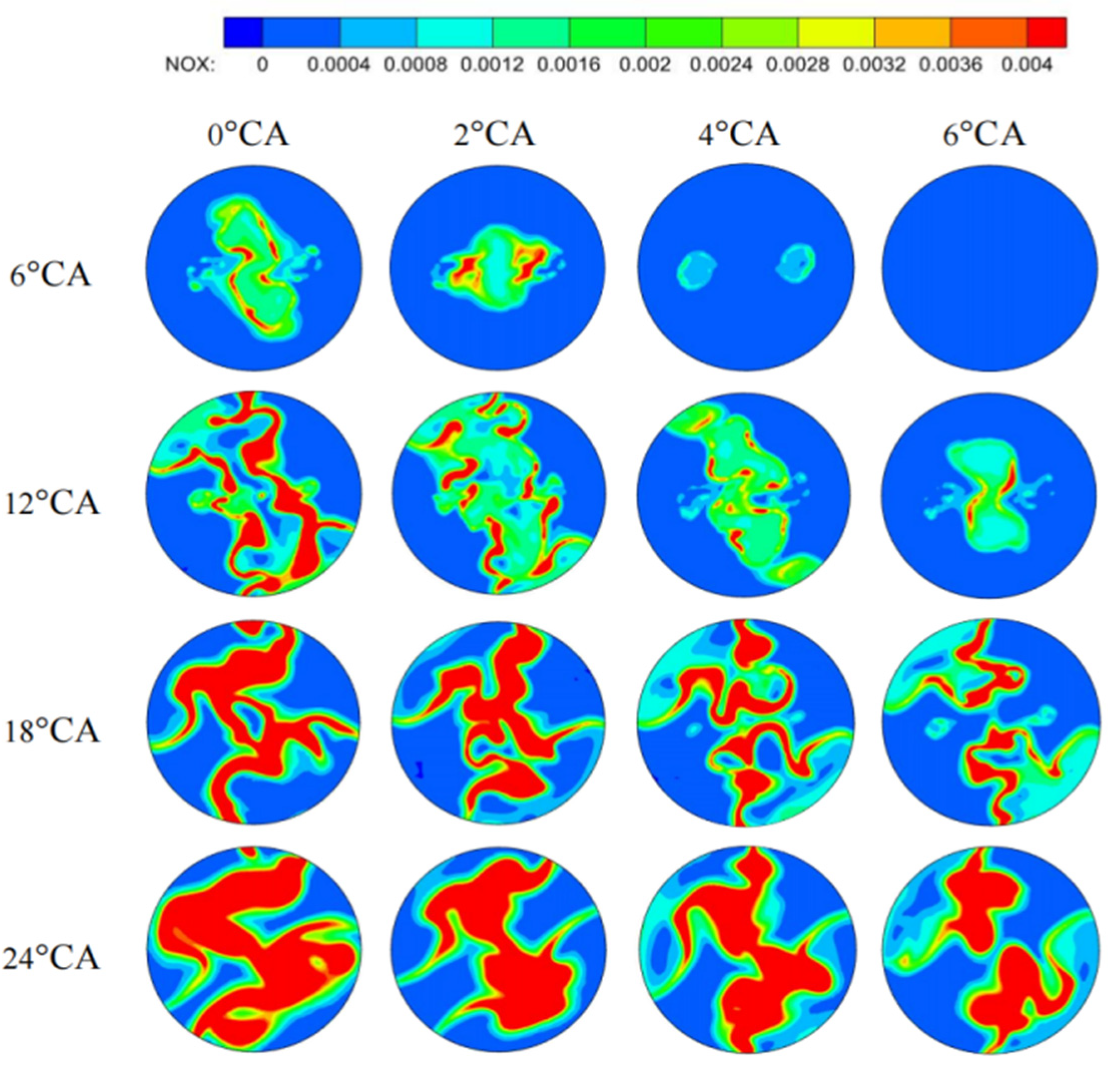
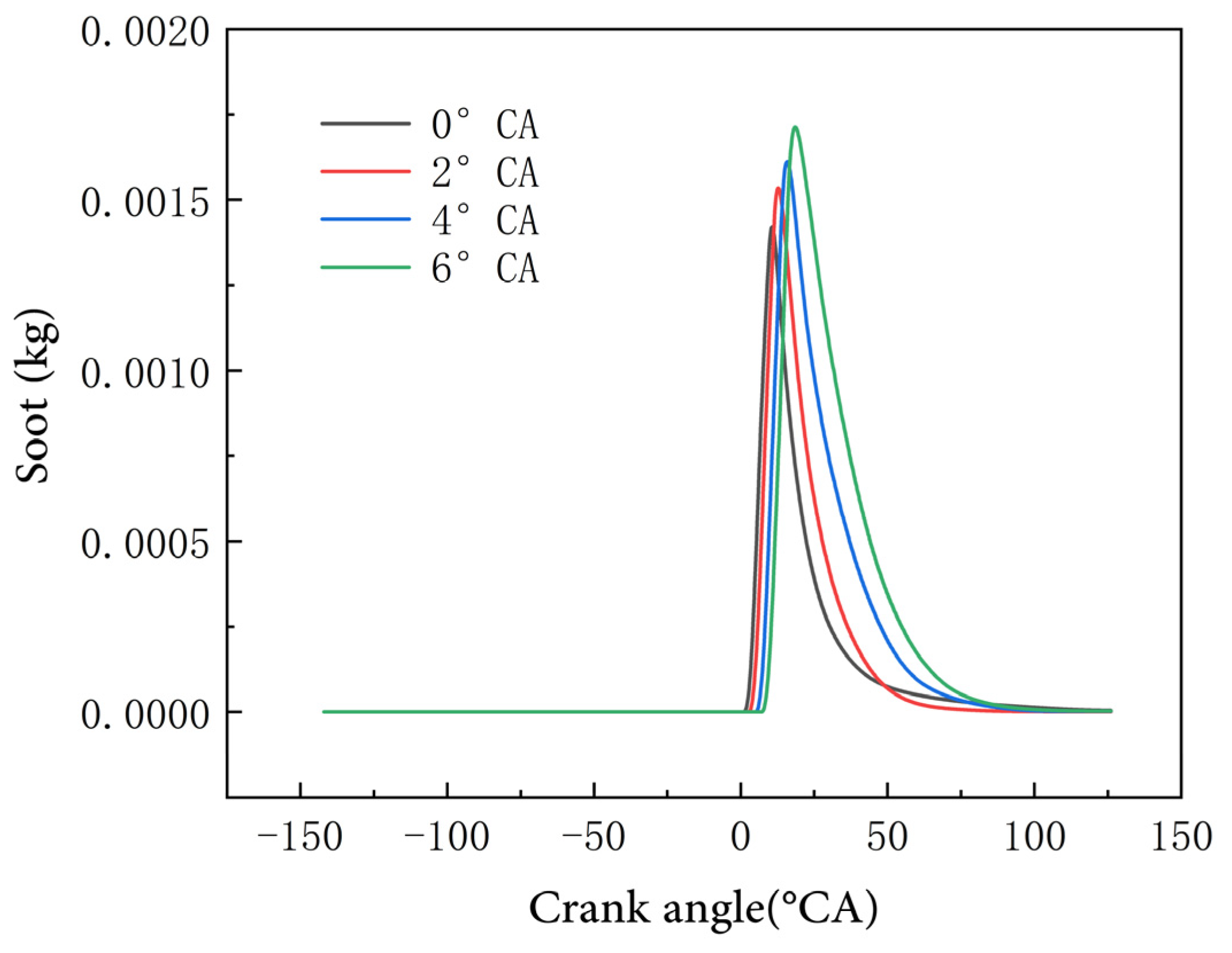

| Item | Parameter |
|---|---|
| Type | In-line 6-cylinder |
| Number of strokes | 2 |
| Firing order (from free end) | 1-5-3-4-2-6 |
| Rated power/kW | 3570 |
| Continuous power/kW | 3250 |
| Rated speed/(r/min) | 142 |
| Connecting rod ratio | 0.5 |
| Compression ratio | 17 |
| Piston/L | 894 |
| stroke/mm | 1550 |
| Cylinder bore/mm | 350 |
| Maximum firing pressure/bar | 180 |
| Item | Parameter |
|---|---|
| Detector | Chemiluminescence (CLD) photodiode |
| NO/NOx measurement range | 0–3000 ppm |
| Repeatability error | <0.5% range |
| Linearity error | <0.5% range |
| Noise effect | <1% range |
| Ambient temperature | 5~40 °C |
| Preheating duration | 1 h |
| Item | Parameter |
|---|---|
| Model | 6613CG2 |
| Sensitivity | 0.05 mA/bar |
| Measurement range | 0~250 bar |
| Mass | 165 g |
| Temperature | −20~350 °C |
| Type | D100 | B10 |
|---|---|---|
| Density (20 °C) kg/m3 | 837.3 | 842.8 |
| Viscosity (40 °C) mm2/s | 3.287 | 3.267 |
| cetane index | 49.5 | 53.0 |
| Low heat value MJ/kg | 42.652 | 41.697 |
| Flash point °C | 70.0 | 77.0 |
| Item | Parameter |
|---|---|
| In-cylinder pressure/MPa | 0.976 |
| In-cylinder temperature/K | 962 |
| Exhaust valve opening/°CA | 117.3 |
| Exhaust valve closing/°CA | 275.9 |
| Scavenging port opening/°CA | 140 |
| Scavenging port closing/°CA | 220 |
| Item | Parameter |
|---|---|
| Turbulence model | RNG k-ε model |
| Combustion model | SAGE model |
| Spray evaporation model | Frossling model |
| Droplet collision model | NTC collision model |
| Droplet wall impingement model | Wall film model |
| Droplet breakage model | KH-RT model |
| NOx emission model | Extended Zeldovich model |
| Soot emission model | Hiroyasu-NSC model |
| Parameter | Experimental Value | Simulated Value | Error |
|---|---|---|---|
| Compression pressure peak (MPa) | 10.62 | 10.91 | 2.73% |
| Firing pressure peak (MPa) | 14.40 | 14.03 | −2.57% |
| NOx emission (g/KW·h) | 14.54 | 15.20 | 4.54% |
Disclaimer/Publisher’s Note: The statements, opinions and data contained in all publications are solely those of the individual author(s) and contributor(s) and not of MDPI and/or the editor(s). MDPI and/or the editor(s) disclaim responsibility for any injury to people or property resulting from any ideas, methods, instructions or products referred to in the content. |
© 2025 by the authors. Licensee MDPI, Basel, Switzerland. This article is an open access article distributed under the terms and conditions of the Creative Commons Attribution (CC BY) license (https://creativecommons.org/licenses/by/4.0/).
Share and Cite
Jiang, G.; Yuan, Y.; Guo, H.; Wu, G.; Chen, J.; Liu, Y. Numerical Simulation Study on Combustion Characteristics of a Low-Speed Marine Engine Using Biodiesel. J. Mar. Sci. Eng. 2025, 13, 824. https://doi.org/10.3390/jmse13040824
Jiang G, Yuan Y, Guo H, Wu G, Chen J, Liu Y. Numerical Simulation Study on Combustion Characteristics of a Low-Speed Marine Engine Using Biodiesel. Journal of Marine Science and Engineering. 2025; 13(4):824. https://doi.org/10.3390/jmse13040824
Chicago/Turabian StyleJiang, Guohe, Yuhao Yuan, Hao Guo, Gang Wu, Jiachen Chen, and Yuanyuan Liu. 2025. "Numerical Simulation Study on Combustion Characteristics of a Low-Speed Marine Engine Using Biodiesel" Journal of Marine Science and Engineering 13, no. 4: 824. https://doi.org/10.3390/jmse13040824
APA StyleJiang, G., Yuan, Y., Guo, H., Wu, G., Chen, J., & Liu, Y. (2025). Numerical Simulation Study on Combustion Characteristics of a Low-Speed Marine Engine Using Biodiesel. Journal of Marine Science and Engineering, 13(4), 824. https://doi.org/10.3390/jmse13040824







